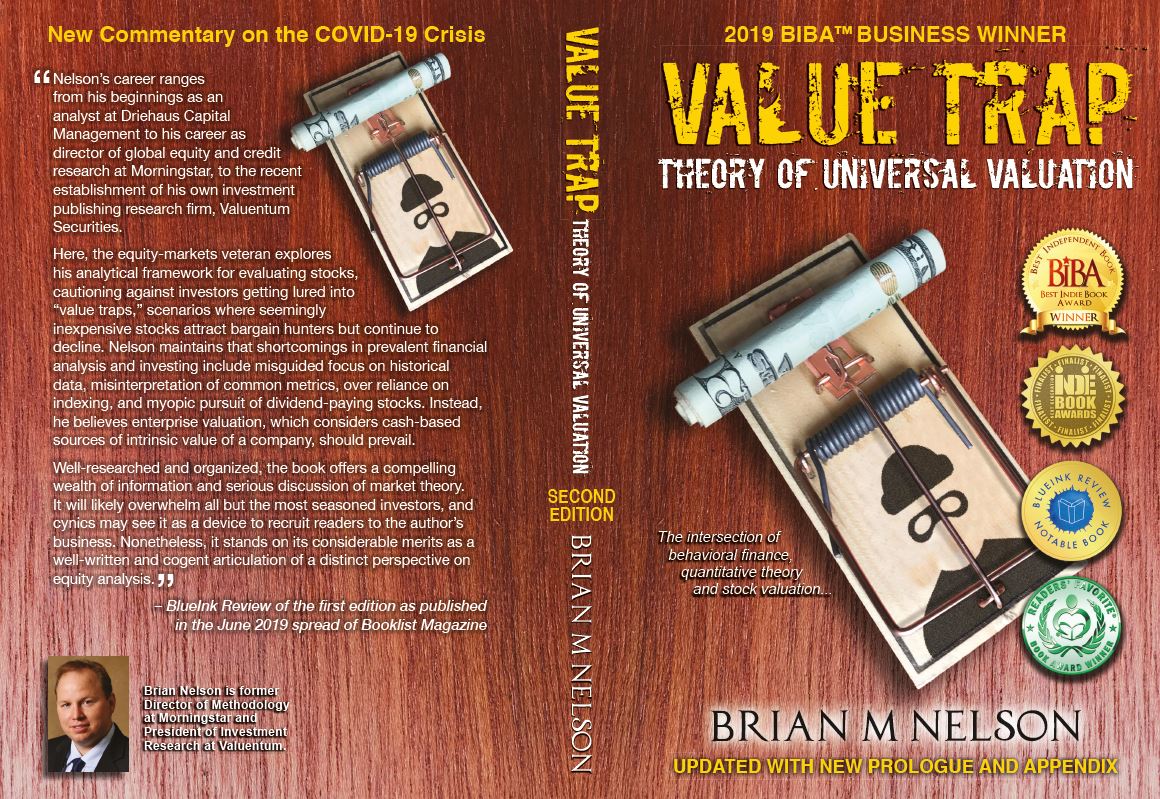Experience and Judgment
publication date: Sep 1, 2020
|
author/source: Brian Nelson, CFA
 Hi everyone:
Hi everyone:---
I think you and I would both agree that there's far too much noise out there. For every investor that believes one thing, another investor might believe the complete opposite. From those pushing market-tracking index funds to those seeking to outperform the market, there's no shortage of paths for an investor to pursue either. There are day-trading aficionados with huge followings on social media and factor-based investing gurus highlighting "science" as the secret to stock market outperformance--and just about everything in between.
---
A number of years ago while I was looking to hire someone on our sales staff at Valuentum, the view came up that research was a commodity. It was weird because, in my view, research is everything, or rather more pointedly, experience and judgment is everything. There are now more than 150,000 CFA charterholders out there. That's a lot to choose from. By some estimates, each year there are nearly 200,000 students in the U.S. alone that are awarded master's degrees in business. That's absolutely incredible. I hold both the CFA distinction and an M.B.A. from the University of Chicago Booth School of Business, but I'd go so far to say that this is not where my value rests. It all comes down to experience and judgment, in my view.
---
I think that's the biggest value add we have. It's the conclusion of the research and analysis that matters. In my career, what I've found, however, is that most analysts can do the analytics, but they end up getting the conclusion all wrong. Any CFA charterholder and M.B.A. graduate, for example, can write up their opinion on the company or build a DCF model, but where we strive to stand out is adding that extra layer of know-how across the board. Think of a DCF model like a baseball bat. It's not so much the bat, itself, that matters, but rather it's the hitter that uses the bat that matters. Two hitters can use the same bat and arrive at a completely different outcome.
---
In my near-10 years working at Valuentum, this concept is the most important one I've sought to emphasize. The DCF model is a tool, much like the baseball bat is the instrument by which the slugger hits home runs. That same bat can lead to a triple crown or set the league record in strike outs. Oftentimes, I see too many investors that care too much about things that fall outside the realm of experience and judgment, relying too much on ambiguous data, or on drivers that don't lead to better outcomes. But it's much more than even the fair value estimate (the output of the DCF), but rather the composition of that fair value estimate, too. Here's what I wrote in the second edition of Value Trap: Theory of Universal Valuation:
---
In our paper, "How Well Do Enterprise-Cash-Flow-Derived Fair Value Estimates Predict Future Stock Prices (2017)," which evaluated a database of 1,194 stocks covered by Valuentum over a time period from early 2012 through mid-June 2017, we found that more than 80% of undervalued stocks experienced price-to-fair value estimate convergence over a 3-year period from the date the fair value estimate was assigned (closing, on average, 30% price gaps), while roughly 40% of overvalued stocks converged to their fair value estimates in the study using the same parameters, despite the time of the data in the study occurring during one of the strongest bull markets in history. In all, approximately 59% of stocks in the study converged to their estimated intrinsic values over a 3-year period from when their fair value estimate was derived.
---
That said, industry structure evaluations and the composition of the intrinsic value estimate--as in the key cash-based sources of intrinsic value (i.e. net cash, future expected free cash flows)--still matter greatly. Let's walk through an example. American Airlines generated $3.79 in earnings per diluted share during 2019 (29). With its stock price closing the year at $28.68, this was good enough for a trailing P/E ratio of about 7.6 times. Many might view this P/E ratio as attractive. However, an evaluation of industry structure (e.g. Porter's 5 forces, the lack of sustainable economic profit creation) would lead one to conclude that the airline business is a notoriously cyclical one with poor competitive dynamics, meaning earnings and free cash flow should be expected to move up and down a lot through the course of the economic cycle.
---
In fact, consistent economic profits, or an ROIC-less-WACC spread, have never happened for airlines. According to the International Air Transport Association, industry-wide ROIC averaged a mere 6.7% during the 5-year period 2014-2018, well below the group's estimated cost of capital, a period that coincides with one of the most prosperous economic environments ever witnessed across the globe (30). There have been hundreds of airline bankruptcies since deregulation in 1978, too, and there has not been one instance where the airline industry's ROIC has exceeded its WAAC in at least the past 20 years through 2018. Even when oil prices collapsed in 2015 and 2016, ROIC still came up short.
---
In the application of enterprise valuation, these conditions manifest themselves in forward-looking fair value estimates for airline equities that are extremely sensitive to their volatile business conditions, resulting in largely unreliable P/FV ratios (as well as a wide range of expected fair value outcomes) on which to base investment decisions. Understanding how industry structure impacts key cash-based sources of intrinsic value (i.e. the sensitivity of future expected free cash flows) revealed how airlines and their seemingly attractive P/E ratios, for example, were quintessential value traps prior to the COVID-19 crisis, even if investors had mistakenly believed they had economic moats.
---
Where there might not be a price at which an investor might pay for an airline (or a P/E ratio quite low enough) given the sensitive nature of their future expected free cash flows, investors may only demand but a modest discount to an informed intrinsic value estimate (and be willing to pay an above-market multiple) to become owners of Apple or Microsoft shares, for example. These entities have strong net cash positions and generate resilient and growing free cash flows (two cash-based sources of intrinsic value). As a result, investors can have greater confidence in their fair value estimates and may even be a bit more lenient on their P/FV considerations given the conviction in the enterprise valuation process that net cash and growing future free cash flows provide.
---
What I'm trying to say is that, when it comes to investing, it's not the bells and whistles that matter--how elaborate or advanced a DCF model is, or the frequency of its update, but rather the experience and judgment that goes into the work. Let me put it this way: It wouldn't matter if we updated the DCF models, fair value estimates and VBI ratings for airlines on a daily basis for the past two years, it wouldn't have changed our opinion of them. In fact, over the past couple years, we've de-emphasized our coverage of airlines, despite Warren Buffett having a large stake prior to the COVID-19 meltdown. This is the experience and judgment I'm talking about.
---
In an investment research service, this is absolutely priceless. This is why we emphasize ideas in the newsletter portfolios so much. Our experience and judgment layered on top of the DCF and Valuentum process has led to these ideas. If you're venturing outside the newsletter portfolios, you're venturing into areas that we don't like as much. Think of us like an all-star hitter. On pitches that we like and swing at--let's say the Exclusive publication, for example--we've hit 80%-90% as a success rate. On pitches that we may not like to swing at, maybe we hit 50%-60% (as in our study referenced above).
---
Not every stock is created equal. It's much easier to evaluate a net cash rich, free cash flow generating powerhouse that has material competitive advantages and is tied to secular growth tailwinds than it is to pinpoint when General Electric may turn around, for example. It's important to think about this. There are going to be pitches that are way outside of the strike zone that we're analyzing, and we might not do as well with them. But then there are going to be our best ideas, those fat pitches right down the plate, that we've done a tremendous job hitting. This is why I emphasize the hierarchy of idea generation so much. We'd much rather highlight those fat pitches in the newsletter portfolios than ones tailing off the outside corner at 100mph.
---
I hope you agree!
------
Kind regards,
---
Brian Nelson, CFA
President, Investment Research
Valuentum Securities, Inc.
brian@valuentum.com
It's Here!
The Second Edition of Value Trap! Order today!

-----
Related: JETS, UAL, ALK, AAL, JBLU, DAL, LUV
---
Factor-based ETFs: VLUE, QUAL, MTUM, SIZE, LRGF, INTF, ACWF, USMV, EFAV, EEMV, FIBR, IGEB, HYDB
---
Valuentum members have access to our 16-page stock reports, Valuentum Buying Index ratings, Dividend Cushion ratios, fair value estimates and ranges, dividend reports and more. Not a member? Subscribe today. The first 14 days are free.
---
Brian Nelson owns shares in SPY, SCHG, DIA and QQQ. Some of the other securities written about in this article may be included in Valuentum's simulated newsletter portfolios. Contact Valuentum for more information about its editorial policies.
0 Comments Posted Leave a comment